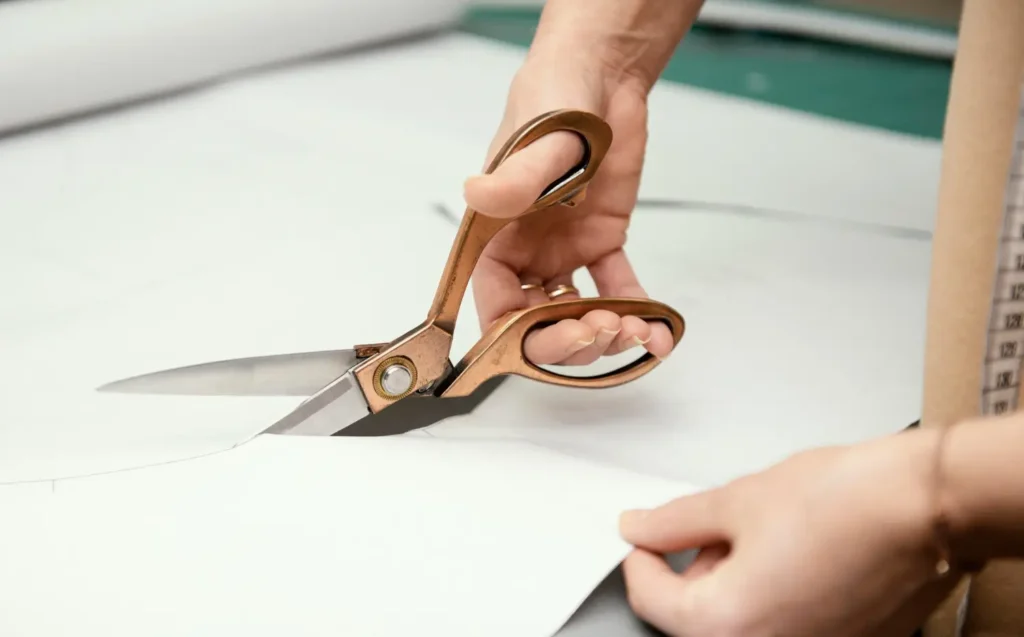Summary
- Cut and sew manufacturers are familiar with the demands of producing exclusive designs in smaller batches.
- To optimize operations and maximize profits, companies need to streamline processes and increase efficiency.
- Audaces360 offers solutions to help you succeed. Try it for free today and discover the best of fashion technology!
Imagine running your cut and sew business without the help of technology. It would be like trying to bake a cake without an oven, right?
From design to cutting, software and hardware allow you to work in a fraction of the time. By relying on task automation, you save time and ensure high quality.
However, selecting the best solution for your business can be challenging. That’s why we’ll explain how to modernize your business and take advantage of the benefits.
Happy reading!
Sumário
Why is it important to monitor cut and sew processes?
With limited production runs, cut and sew companies rely heavily on the profit margin from each unit. To maximize the bottom line, you must have complete control over every stage of the production process.
Identifying areas of waste allows you to take action to cut costs. For instance, you can target processes that use too much material or bottlenecks that cause delays.
Moreover, it’s a way to maintain product quality. If something is wrong, you’ll notice it at the beginning of the process and can correct it in time.
With the support of current data, you can make more informed business choices. This means making strategic decisions at the optimal time, like expanding your operations or investing in new machinery.
Learn more: Should my company become a clothing manufacturer?
What is cut and sew?
Cut and sew manufacturing is a way to make clothes from scratch. It works well when you need small batches of clothing. For example, it’s perfect for a brand that wants to offer limited designs or custom products.
It’s very different from mass production, where factories make thousands of the same items at once.
Instead of cutting and sewing each item one at a time, mass production uses big machines to cut many layers of fabric.
The sewing stage, on the other hand, is very quick with less focus on unique details.
Learn more: How to pick the best clothing design software for your brand
What are the steps in the cut and sew manufacturing process?

Despite the differences in flexibility between cut and sew and mass production, there are many common steps.
Usually, after design approval, the production follows this order:
Pattern making
Pattern making is the initial stage of cut and sew manufacturing. It involves converting the design and its measurements into a pattern for the garment.
The pattern outlines each piece of the garment, such as the front, back, sleeves, and other components. It ensures the final product has the correct fit, shape, and style.
Companies typically create them using a computer-aided design (CAD) software solution. They allow for precise measurements and adjustments.
This prevents mistakes and improves efficiency by reducing the need for corrections.
Learn more: Learn how to choose the best fashion CAD for your business
Marking
Marking is the process of preparing the fabric for cutting by laying out the pattern pieces on the material. The goal is to position the pieces efficiently, optimizing fabric usage.
By doing this digitally, you eliminate fabric waste. Algorithms calculate the best distribution of patterns, leaving the smallest possible space between them.
This process offers a significant speed advantage over manual methods. This way, you can meet more demanding deadlines.
In addition, you can expand your customer base by increasing the performance of your cut and sew production.
Tired of searching for different solutions? Discover Audaces360, your all-in-one platform for streamlined production:
Cutting
Once the marking is ready, the cutting process begins. Using the pattern as a guide, the fabric is cut into individual pieces that will later be sewn together.
Specialized machines cut through multiple layers of fabric, making the process very fast.
This is one of the parts that require the most attention in production. After all, incorrect cuts can mean wasting an entire batch of fabric.
Precision is also important during cutting to ensure that all the pieces fit together perfectly in the next stage.
To ensure everything goes according to the plan, it’s ideal to rely on technology. Through digital management, you can have complete control of your cutting room. Track production downtime, cut orders, and address any challenges that arise.
Learn more: How to overcome slow cutting in your apparel manufacturing?
Sewing
After cutting, the individual fabric pieces are assembled and sewn together to form the garment. The process follows a specific sequence, starting with joining key parts like the main body or sleeves.
Before moving on to the final sewing phase of the fabric, you can digitally simulate and test the seams.
Simulating a prototype allows you to test the patterns and see a preview of the finished product. This gives you the opportunity to correct any issues before production, ensuring a flawless result.
Learn more: Learn how to use sewing darts in clothing manufacturing
5 benefits of using technology for cut and sew

1) Higher precision in production
Technologies like CAD software and automated cutting machines enable precise pattern making and cutting.
This level of accuracy ensures perfect garment parts. It leads to better-fitting items and minimizes errors that could arise from manual work.
The ability to create complex patterns with ease enables manufacturers to produce a wider variety of designs. This way, you can attract a larger customer base.
Learn more: Why should your company invest in fabrication technology?
2) Reduced material waste
By leveraging digital solutions, you can create markers in the most efficient way possible. It optimizes fabric use and significantly reduces material waste.
Automated cutting machines can follow the lines exactly, avoiding unnecessary fabric scraps. They ensure the fullest potential usage of each piece of fabric.
Additionally, this approach promotes more sustainable practices, a key concern for many brands today. You can highlight this aspect to attract new customers.
Learn more: 8 sustainability trends in the textile industry
3) Increased productivity
Automation speeds up many steps in cut and sew production, such as cutting multiple layers of fabric.
This increased efficiency allows manufacturers to produce more garments in less time. It boosts productivity and lets you meet higher demand.
Automated systems also reduce the need for manual intervention, minimizing human error and downtime.
It shortens production cycles, enabling companies to respond more quickly to the clients’ needs.
4) Improved quality
Technology helps maintain consistency across all products, ensuring that each item meets the same high standards. It results in fewer defects and higher customer satisfaction.
Equipment with automated quality checks can detect issues that may go unnoticed during manual inspection. For instance, advanced cutting machines can pinpoint defects like holes in the fabric.
Having attention to detail reduces the number of defective garments. This enhances the company’s reputation for producing reliable, high-quality products.
Learn more: What is industrial quality control in the textile business and how does it work?
5) Faster processes
Efficient hardware allows for faster turnaround times at each stage of production. They help handle repetitive tasks more quickly than manual labor.
Meanwhile, software solutions make it easier to modify patterns or markings on the go. This results in a more streamlined production process
With real-time data tracking, cut and sew manufacturers can also monitor progress. Track each stage and identify potential delays before they become major issues.
Meeting deadlines builds customer confidence and leads to long-term partnerships.
Choose the best technology for your cut and sew manufacturing

Audaces360
Audaces360 integrates cutting-edge digital solutions to optimize workflows in the fashion industry. It caters to companies of all sizes and types, offering the flexibility to scale with your business needs.
All solutions fit the specific challenges of sew and cut manufacturing. They accelerate your development and production processes, saving time and resources.
Among the benefits for your daily work is creating high-quality patterns and achieving precise grading with ease.
Audaces Pattern allows you to complete these tasks in a matter of minutes, thanks to its efficient tools.
The following step involves using Audaces 3D to test the patterns. This advanced software enables you to visualize how the patterns will fit on a virtual mannequin.
Simulate the fit, drape, and seams to eliminate the need for physical samples. Complete the entire approval process digitally, saving both time and costs.
Interested in learning more? Discover Audaces360 and explore our comprehensive suite of solutions for fashion design.
FAQ
With limited production runs, cut and sew companies rely heavily on the profit margin from each unit. To maximize the bottom line, you must have complete control over every stage of the production process.
Cut and sew manufacturing is a way to make clothes from scratch. It works well when you need small batches of clothing. For example, it’s perfect for a brand that wants to offer limited designs or custom products.
Pattern making, marking, cutting, and sewing.










